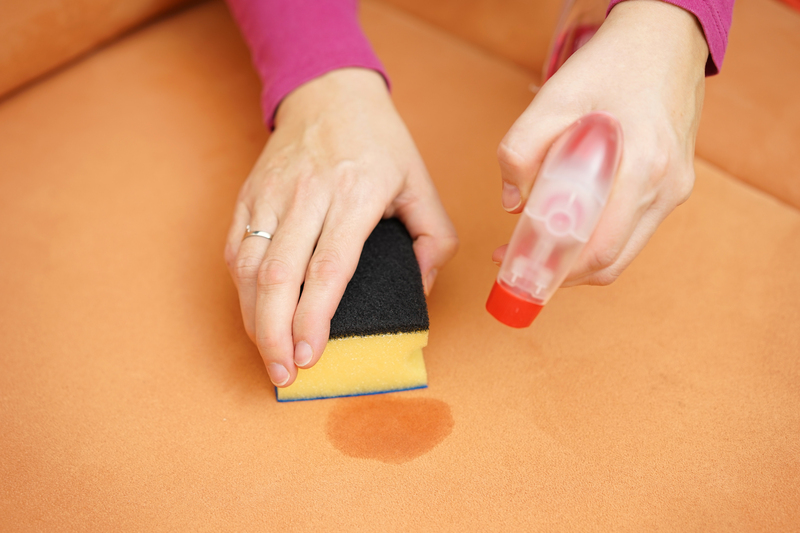Strategies to Maintain a Mold-Free Bathroom
Posted on 14/09/2025
Strategies to Maintain a Mold-Free Bathroom
A clean and healthy bathroom is crucial for overall household well-being. One of the most persistent problems in this area is mold growth, which not only looks unsightly but also carries potential health risks. This comprehensive guide explores proven strategies to maintain a mold-free bathroom, delving into effective prevention methods, cleaning routines, and maintenance tips. Whether you're a new homeowner or a seasoned caretaker, these actionable insights will help you achieve and sustain a mold-free environment in your bathroom.
Understanding Mold in the Bathroom
Mold thrives in damp, warm, and poorly ventilated environments--conditions commonly found in bathrooms. It can develop on a variety of surfaces, including tiles, grout, ceilings, walls, and even personal care products. Frequent exposure to bathroom mold may cause respiratory issues, allergies, and damage to fixtures or building materials.
Common Types of Bathroom Mold
- Black mold (Stachybotrys chartarum): Recognizable by dark greenish-black spots, this type is particularly notorious for its health risks.
- Aspergillus: Often yellow, green, or black, it flourishes in humid areas and can trigger allergic reactions.
- Cladosporium: Usually brown, green, or black, this mold can grow on wood, fittings, and textiles within bathrooms.
Early identification is key to minimizing mold's impact. For full protection, it's vital to implement comprehensive bathroom mold prevention techniques and stay attentive to emerging problems.

Why Bathrooms Are Susceptible to Mold Growth
- High Humidity: Showers and baths increase humidity, often leading to condensation on walls and ceilings.
- Poor Ventilation: Insufficient airflow traps moisture, creating an ideal environment for mold spores.
- Leaky Fixtures: Dripping faucets and slow leaks keep surfaces damp, promoting fungal growth.
- Neglected Cleaning: Infrequent or improper cleaning lets mold spores settle and multiply.
Given these inherent challenges, understanding and using mold control strategies for bathrooms is essential for homeowners and renters alike.
Effective Strategies to Keep Your Bathroom Mold-Free
1. Maximize Airflow and Ventilation
A well-ventilated bathroom is your first line of defense against mold. To maintain a mold-free bathroom:
- Install or Upgrade Exhaust Fans: Select a fan with the appropriate CFM (cubic feet per minute) rating for your bathroom's size. Run it during and after showers, ideally for 15-30 minutes.
- Open Windows and Doors: Whenever possible, create cross-ventilation by leaving windows or the bathroom door slightly open.
- Avoid Overcrowding: Minimize the number of dense items and textiles, such as extra towels or decorative fabrics, which can retain moisture.
*Tip:* Consider modern, humidity-sensing exhaust fans for automatic moisture control.
2. Control Humidity Levels
Humid environments accelerate mold development. Maintain optimal humidity levels with these steps:
- Use a Dehumidifier: If your bathroom stays humid, place a small dehumidifier to keep humidity below 50%.
- Monitor With a Hygrometer: Inexpensive digital hygrometers make it easy to track and manage moisture.
- Keep Showers Short and Cooler: Less steam means less opportunity for condensation and subsequent mold growth.
3. Promptly Address Leaks and Plumbing Issues
Unchecked leaks are a hidden source of persistent moisture and can cause severe mold infestations in bathrooms. Therefore:
- Fix Leaky Faucets and Pipes: Address dripping taps or under-sink leaks immediately, and check all water supply connections regularly.
- Seal Bathtub and Shower Edges: Use waterproof caulk to ensure water doesn't seep behind tiles or walls.
- Inspect Toilet Bases: Look for water pooling around the base, which may signal a defective wax ring or a broken seal.
4. Dry Wet Surfaces Immediately
Mold requires lingering moisture to grow. Make it a habit to dry shower walls, bathtub surfaces, bathroom mirrors, and tiles after use:
- Use Squeegees: Run a squeegee over tiles and glass doors to remove water droplets.
- Towel Off: Use a dedicated cloth for countertops and floors, removing puddles or condensation quickly.
- Hang Bathmats and Towels to Air Dry: Always air out textiles on towel bars or hooks, never leaving them heaped on the floor.
5. Implement a Consistent Cleaning Schedule
A proactive cleaning routine stops mold before it can take hold. For bathroom mold prevention:
- Clean Weekly: Focus on grout lines, corners, and shower doors, where mold is most likely to appear.
- Use Mold-Inhibiting Cleaners: Choose bathroom products that kill mold spores and remove biofilm buildup.
- Deep Clean Monthly: Pay special attention to hard-to-reach areas, exhaust fan covers, and behind fixtures.
Cleaning not only maintains appearances but also ensures a healthy indoor climate.
Mold-Resistant Materials and Products
Upgrade Finishes for Long-Term Mold Protection
Investing in mold-resistant bathroom materials makes a lasting difference. Here are some smart choices for remodeling or maintenance:
- Mold-Resistant Drywall or Cement Board: Replace traditional drywall in moisture-prone areas.
- Mildew-Resistant Paint: Use approved paints formulated for damp conditions.
- Silicone-Based Grout and Sealants: Silicone provides better waterproofing than standard grout, reducing water seepage.
- Non-Porous Surfaces: Opt for ceramic, porcelain, or glass over porous materials, minimizing mold's attachment points.
Smart Accessory Choices
Certain bathroom accessories can support your mold prevention strategy:
- Quick-Dry Bath Mats: These reduce moisture retention and dry faster after use.
- Plastic or Vinyl Shower Curtains: Choose machine-washable, mold-resistant options.
- Well-Designed Storage: Keep toiletries off crowded surfaces, allowing air to circulate freely.
Natural and Chemical Mold Prevention Methods
Natural Mold Prevention Techniques
Many homeowners prefer natural ways to prevent mold in the bathroom. Here are effective methods:
- White Vinegar: Spray undiluted vinegar on problem surfaces weekly, then rinse after an hour.
- Baking Soda: Mix baking soda with water to form a paste; apply to grout, scrub, and rinse thoroughly.
- Hydrogen Peroxide: A 3% hydrogen peroxide solution is an antifungal and antibacterial cleaner--spray it onto tiles and allow it to work for 10 minutes before scrubbing.
*Note:* These methods are eco-friendly and reduce exposure to harsh chemicals while being gentle on bathroom surfaces.
Commercial Mold Prevention Products
- Mold-Resistant Sprays: Antimicrobial sprays prevent spore regrowth after surface cleaning. Apply regularly in high-risk areas.
- Preventive Shower Sprays: Ready-to-use sprays can be misted after every shower session to deter mold and soap scum accumulation.
- Bleach-Based Cleaners: For stubborn mold, dilute bleach cleans dark stains--but always ventilate well and never mix with ammonia-based products.
Always follow manufacturer instructions and use gloves or masks for safety when applying chemical cleaners.
Routine Bathroom Maintenance Tips
Establish a Proactive Maintenance Checklist
- Monthly Grout Care: Examine tile grout for cracks or discoloration; repair or reseal as required to block water intrusion.
- Quarterly Vent Fan Inspection: Clean exhaust fan covers and test for continuous operation.
- Annual Deep Cleaning: Remove hard water deposits and accumulated grime from all bathroom surfaces, including taps and drains.
- Waterproof Caulking Check: Inspect seals around bathtubs, sinks, and showers, reapplying caulk promptly where wear is evident.
Smart Habits for Everyday Use
- Shower With the Curtain or Door Closed: Prevent water splashing and spreading across the bathroom floor.
- Wipe Up Spills Quickly: Address water on floors or countertops as soon as possible.
- Regularly Replace Loofahs and Sponges: These can harbor and spread mold if left damp and unused.
Dealing With Existing Mold Problems
How to Safely Remove Bathroom Mold
Despite your best efforts, minor mold outbreaks may still occur. Removing bathroom mold safely involves:
- Wearing Protective Gear: Use gloves, goggles, and a mask to avoid inhaling spores.
- Cleaning Small Areas: For patches under 10 square feet, clean with vinegar, hydrogen peroxide, or a bathroom mildew cleaner and scrub with a stiff brush.
- Dry Thoroughly After Cleaning: Ensure all surfaces are fully dry to discourage regrowth.
For persistent or extensive outbreaks--especially black mold--consult a professional mold remediation specialist. Mold behind walls or in ceilings often requires specialized equipment and expertise.

Frequently Asked Questions
How can I tell if I have a mold problem in my bathroom?
Visible mold in the bathroom often appears as black, green, or brown spots on grout, caulk, or walls. A musty odor is another common sign. If you suspect mold in hidden areas, such as behind tiles or drywall, it's best to get a professional inspection.
Are there any bathroom plants that help prevent mold?
Some air-purifying plants like ferns, peace lilies, and snake plants can absorb moisture, indirectly reducing humidity. However, ensure proper drainage because overwatered plants may increase the risk of mold.
How often should I clean to prevent bathroom mold?
At a minimum, stick to a weekly cleaning schedule for all bathroom surfaces and do a more thorough deep clean monthly. Immediately address any moisture or leaks for optimal mold control.
Conclusion: A Mold-Free Bathroom for Healthier Living
Implementing a thorough combination of mold prevention strategies for bathrooms is essential to protect both your household's health and the longevity of your home. By prioritizing good ventilation, timely cleaning, swift repair of leaks, and the use of mold-resistant materials, you can enjoy a consistently fresh, hygienic, and mold-free bathroom environment.
Stay vigilant, maintain smart daily habits, and respond quickly to signs of moisture or growth. By following these comprehensive tips and preventive measures, you're well-equipped to keep your bathroom sparkling--and free from the dangers of mold--year after year.
- Maximize ventilation.
- Manage humidity.
- Fix leaks immediately.
- Keep surfaces dry.
- Clean regularly and deeply.
For ongoing bathroom health, prevention is always better--and easier--than cure. Start implementing these strategies today for a mold-free future!




